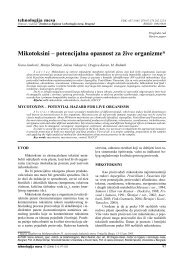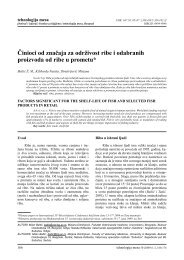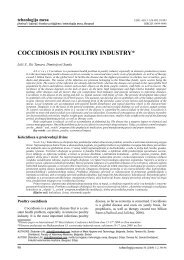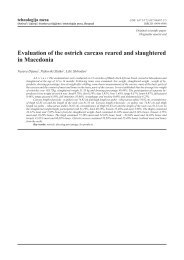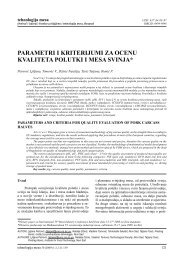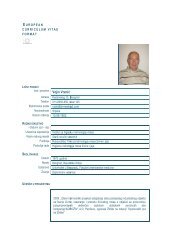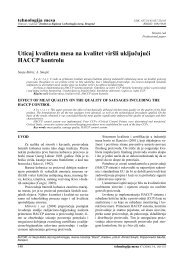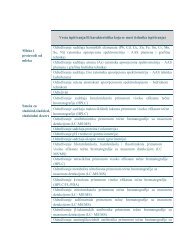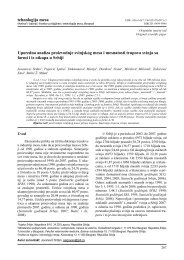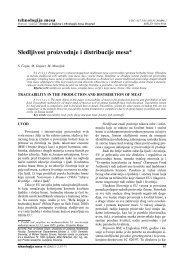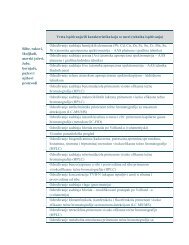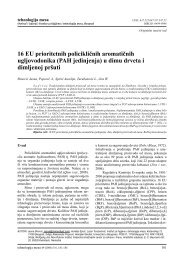Zbornik radova MeÄunarodnog 55. savetovanja ... - inmesbgd.com
Zbornik radova MeÄunarodnog 55. savetovanja ... - inmesbgd.com
Zbornik radova MeÄunarodnog 55. savetovanja ... - inmesbgd.com
- No tags were found...
You also want an ePaper? Increase the reach of your titles
YUMPU automatically turns print PDFs into web optimized ePapers that Google loves.
50<strong>Zbornik</strong> kratkih sadržaja / Book of AbstractsOCCURRENCE OF LAB AND MIC SPECIES DURING THEPRODUCTION OF „SREMSKA” SAUSAGEBorovic Branka, Velebit B., Jankovic Vesna, Veskovic-Moracanin Slavica,Tomicevic Sanja, Jovanovic Suncica, Petrovic Vesna„Sremska” sausage is a typical representative of fermented sausages in ourcountry and it is traditionally produced in households or small manufactures. It consistsof pork, bacon and spices. Specific spices used in the production of “Sremska”sausage are ground paprika and garlic.Samples of “Sremska” sausage are produced in industrial conditions in A. D.“Yuhor”, Jagodina by the recipe and technology of the producer, in accordance withthe traditional way of production.A characteristic of the production process was that, besides nitrite salt, saccharose,paprika and garlic, black pepper extract was used.Sausage filling was stuffed into pork small intestine. Sausages were smoked bythe cold procedure followed by drying and ripening. The final product was of highquality.The production of this, fermented product, is the result of the metabolic activityof present and adapted bacteria in meat, spices microflora and natural casings, aswell as the activity of enzymes from chopped meat.The aim of this paper was to isolate lactic acid bacteria (LAB) and bacteriafrom Micrococcaceae family (MIC), as well as their identification.In various ripening stages from the starting point of sausages production (0 th ,2 nd , 4 th , 7 th , 14 th and 21 st day of production), 150 species of LAB and 50 species ofMIC was isolated by classical microbiological methods. Final identification of isolateswas carried out using biochemical tests API-50 CHL and API-Staph.The investigation results showed that dominant microflora during the productionof «Sremska» sausage consists of the following species: Lactobacillus delbrueckissp. delbruecki, Leuconostoc mesenteroides ssp.mesenteroides, Lb. Curvatus,Ln. Mesenteroides ssp. Cremoris, Pediococcus pentosaceus, Lb. Cellobiosus,Lb.delbruecki ssp. Bulgaricus, Lb. Plantarum, Lb. Brevis. The most frequent speciesfrom Micrococcaceae family were: Staphylococcus xylosus and Micrococcus spp.Key words: „Sremska” sausage, LAB, MIC, classical microbiological methods,API identificationAUTHORS: Branka Borovic, DVM, spec.mikcob., Branko Velebit MsC, Vesna Jankovic, dipl.biologist, spec.microb., Slavica Vesković-Moracanin PhD, spec., Sanja Tomicevic,chem technician, Institute of Meat Hygiene and Technology, Belgrade; SuncicaJovanovic, DVM, Vesna Petrovic, eng. techn. IM “Juhor”AD, Jagodina.Note: The results presented in this paper are part of the research project:”Technologicaland Protective Properties of Autochtonous Strains of Lactic Acid Bacteria Isolated from TraditionallyFermented Sausages and Possibilities of their Application in Meat Industry” No.20127 fi nanced by Ministry of Science of Reublic of Serbia.



